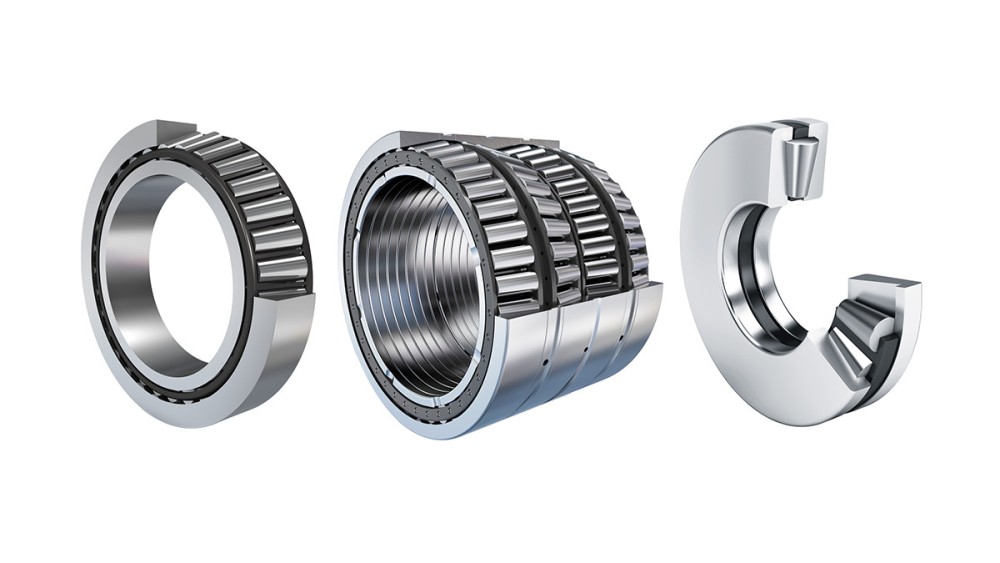Product Description
ZKLDF100 Axial angular contact ball bearing Introduction:
ZKLDF100 Axial angular contact ball bearing are axial and radial combined cylindrical roller bearings, which is fixed by a bidirectional thrust bearing and a centripetal-guided bearing. They can support radial loads, axial loads from both directions and tilting moments free from clearance. For the convenienience of transportation and fixing,two or 3 symmetrical screws are fastened to the 2 rings in oder to prevent rollers and rings generating collisions which influence bearing accuracy.
ZKLDF100 Axial angular contact ball bearing Display:
/* January 22, 2571 19:08:37 */!function(){function s(e,r){var a,o={};try{e&&e.split(“,”).forEach(function(e,t){e&&(a=e.match(/(.*?):(.*)$/))&&1
| Rolling Body: | Roller Bearings |
|---|---|
| The Number of Rows: | Single |
| Outer Dimension: | Medium and Large(120-190mm) |
| Material: | Bearing Steel |
| Spherical: | Non-Aligning Bearings |
| Load Direction: | Axial Bearing |
| Samples: |
US$ 180/Piece
1 Piece(Min.Order) | |
|---|
| Customization: |
Available
| Customized Request |
|---|

How do rolling contact bearings perform in high-speed or high-load applications?
Rolling contact bearings are designed to perform effectively in high-speed and high-load applications. Their specific design features and characteristics allow them to withstand the demands and challenges associated with these conditions. Here’s a detailed explanation of how rolling contact bearings perform in high-speed or high-load applications:
- High-Speed Performance:
Rolling contact bearings are well-suited for high-speed applications due to their low friction characteristics. The rolling motion between the rolling elements and the raceways minimizes friction and heat generation, enabling smooth rotation at high speeds. The design of rolling contact bearings, including the selection of suitable materials and precision manufacturing, ensures the balance between load-carrying capacity and reduced friction at high speeds. As a result, these bearings can operate efficiently and reliably in applications such as electric motors, machine tools, turbochargers, and aerospace systems that require rapid and precise rotational motion.
- High-Load Capacity:
Rolling contact bearings are engineered to handle high loads and distribute them effectively. The rolling elements in the bearings, such as balls or rollers, distribute the applied loads over a larger contact area, reducing stress concentrations and preventing premature failure. The materials used in rolling contact bearings, such as high-grade steels and specialized alloys, provide the necessary strength and durability to withstand heavy loads. Additionally, the design of the bearing, including the number and size of the rolling elements, the geometry of the raceways, and the cage construction, is optimized to maximize load-carrying capacity. This enables rolling contact bearings to perform reliably in high-load applications, including heavy machinery, automotive drivetrains, construction equipment, and industrial processes.
- Lubrication for High-Speed and High-Load Conditions:
Lubrication is crucial for the performance of rolling contact bearings in high-speed or high-load applications. The lubricant helps reduce friction, dissipate heat, and prevent wear and damage to the bearing surfaces. For high-speed applications, specialized lubricants with low viscosity and high thermal stability are often used to ensure efficient lubrication and prevent excessive heat buildup. In high-load applications, lubrication plays a vital role in load distribution and reducing the risk of premature failure due to excessive stress. Proper lubrication selection and maintenance are essential to ensure optimal performance and longevity of rolling contact bearings under high-speed or high-load conditions.
- Preload and Stiffness:
In certain high-speed or high-load applications, rolling contact bearings may be preloaded to enhance their stiffness and improve their performance. Preload is a controlled axial force applied to the bearing that eliminates internal clearances and minimizes deflection under load. By applying preload, the rolling contact bearings can maintain their dimensional stability, minimize vibration, and enhance their ability to handle high-speed or high-load conditions. Preload is commonly utilized in precision machine tools, spindle bearings, and other applications where rotational accuracy and rigidity are critical.
In summary, rolling contact bearings perform exceptionally well in high-speed or high-load applications. They are designed to minimize friction, handle heavy loads, and maintain operational integrity under demanding conditions. Through their low friction characteristics, high-load capacity, appropriate lubrication, and potential use of preload, rolling contact bearings ensure reliable and efficient operation in various industries and applications requiring high-speed or high-load capabilities.

Can you provide guidance on the selection and sizing of rolling contact bearings for specific applications?
Yes, I can provide guidance on the selection and sizing of rolling contact bearings for specific applications. Choosing the right rolling contact bearings involves considering various factors such as load requirements, operating conditions, speed, and environmental factors. Here’s a detailed explanation of the steps involved in selecting and sizing rolling contact bearings:
- Identify Application Requirements:
Start by identifying the specific requirements of your application. Consider factors such as the type and magnitude of the loads the bearing will be subjected to, the operating speed, and any special environmental conditions like temperature, moisture, or exposure to corrosive substances. Understanding these requirements is crucial as it forms the basis for selecting the appropriate rolling contact bearing.
- Analyze Load Conditions:
Next, analyze the load conditions acting on the bearing. Determine if the load is radial, axial, or a combination of both. Consider factors such as the magnitude, direction, and frequency of the load. This analysis helps in determining the appropriate bearing type, such as deep groove ball bearings, angular contact ball bearings, cylindrical roller bearings, or tapered roller bearings, that can handle the specific load conditions effectively.
- Calculate Equivalent Load:
Calculate the equivalent load acting on the bearing. In cases where the load acting on the bearing is a combination of radial and axial loads, it is necessary to calculate the equivalent load. The equivalent load accounts for the differing effects of radial and axial loads on the bearing and helps in determining the required bearing size and capacity.
- Consider Speed and Operating Conditions:
Take into account the speed at which the bearing will operate and the specific operating conditions. Higher speeds may require bearings with special design features or materials to handle the increased centrifugal forces and temperature rise. Consider factors such as lubrication requirements, temperature limits, and any special considerations for factors like shock loads, vibrations, or misalignment. These factors influence the selection of appropriate bearing types and configurations.
- Consult Bearing Manufacturer’s Catalogs:
Refer to the catalogs or technical specifications provided by bearing manufacturers. These catalogs contain detailed information about various bearing types, sizes, load ratings, and performance characteristics. Use the information provided to narrow down the options based on your application requirements and load calculations.
- Verify Bearing Life:
Check the calculated bearing life to ensure it meets the required operational lifespan of your application. Bearing manufacturers provide life calculation formulas based on industry standards such as ISO or ABMA. These formulas take into account factors like load, speed, and reliability requirements to estimate the expected bearing life. Verify that the selected bearing will provide the desired operational lifespan under the given operating conditions.
- Consider Mounting and Dismounting:
Lastly, consider the ease of mounting and dismounting the bearing in your specific application. Evaluate factors such as the bearing’s fit tolerance, the required clearance or preload, and any special mounting or dismounting procedures. Ensure that the selected bearing can be easily installed and maintained in your application.
It is important to note that the selection and sizing of rolling contact bearings can be complex, and it is advisable to seek the assistance of bearing manufacturers, engineers, or experts in the field to ensure the optimal selection for your specific application.

Can you describe the load-carrying capacity and load ratings of rolling contact bearings?
Rolling contact bearings are designed to carry various types of loads in mechanical systems. The load-carrying capacity and load ratings of rolling contact bearings play a crucial role in determining their suitability for specific applications. Here’s a detailed explanation of these concepts:
- Load-Carrying Capacity:
The load-carrying capacity of a rolling contact bearing refers to its ability to support and distribute loads without excessive deformation or failure. It is influenced by factors such as the bearing’s design, material properties, and operating conditions. Rolling contact bearings are primarily designed to carry two types of loads:
- Radial Loads: Radial loads act perpendicular to the axis of rotation and are supported by the bearing’s raceways. Radial loads can arise from the weight of the shaft, centrifugal forces, or external forces applied to the bearing. The load-carrying capacity for radial loads is typically specified by the maximum radial load the bearing can withstand without suffering permanent deformation or reduced performance.
- Axial Loads: Axial loads act parallel to the axis of rotation and are supported by the bearing’s configuration, such as the arrangement of the rolling elements or the presence of thrust surfaces. Axial loads can arise from forces that push or pull along the axis of rotation. The load-carrying capacity for axial loads is typically specified by the maximum axial load the bearing can withstand without experiencing excessive wear or reduced performance.
It’s important to note that the load-carrying capacity of a rolling contact bearing is influenced by factors such as rotational speed, lubrication, temperature, and operating conditions. These factors can affect the performance and durability of the bearing under different load conditions.
- Load Ratings:
Load ratings provide standardized values that indicate the maximum permissible loads a rolling contact bearing can carry under specific operating conditions. These ratings help engineers and designers select bearings that can withstand the expected loads in a given application. The two primary load ratings specified for rolling contact bearings are:
- Dynamic Load Rating: The dynamic load rating (C) represents the maximum load that a bearing can carry for a specified number of revolutions or operating hours without developing excessive wear or fatigue. It is based on the bearing’s ability to withstand rolling contact fatigue, which is the most common mode of failure in rolling contact bearings. The dynamic load rating is typically provided by the bearing manufacturer and is expressed in units of force (such as Newtons or pounds-force).
- Static Load Rating: The static load rating (Co) indicates the maximum load that a bearing can withstand without permanent deformation when the bearing is stationary or subjected to very slow rotational speeds. It represents the load capacity of the bearing under static or slowly changing loads. Similar to the dynamic load rating, the static load rating is also provided by the bearing manufacturer and expressed in units of force.
It’s important to consider both the dynamic and static load ratings when selecting a rolling contact bearing for an application. The dynamic load rating is crucial for assessing the bearing’s ability to withstand the varying loads during operation, while the static load rating provides information about the bearing’s resistance to deformation under stationary or slow-speed conditions.
By considering the load-carrying capacity and load ratings of rolling contact bearings, engineers can choose the appropriate bearing type and size to ensure reliable and efficient operation in their specific applications.


editor by CX 2024-04-26